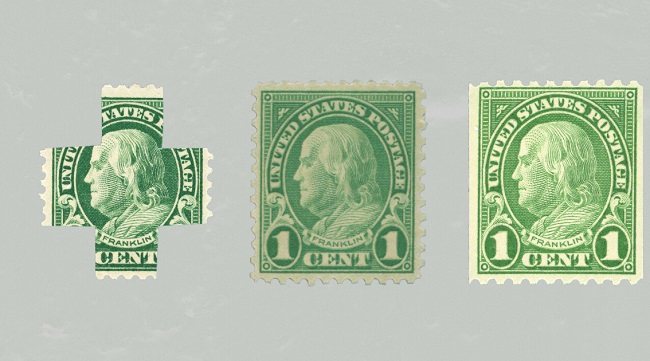Largest Quantity of the Color Green, Value 1 While most Benjamin Franklin stamps sell for less than a dollar, two rotary press types that look nearly identical to standard flat-plate issues sell for thousands. Ken Lawrence elaborates on how to recognise and interpret the unusual cases.
Do You Have Scott 594 or 596 For the United States?
In all likelihood, no. Listed below are the horizontally and vertically perforated 1924 1 green Benjamin Franklin rotary press stamps (Scott 594 and 596, respectively), which are gauge 11.

From 1922 until 1938, the United States Postal Service produced stamps with a face value of 1 cent. The green Franklin stamps are among the most widely collected of these issues. Expert stamp collectors can spot the difference, but to the untrained eye, they look similar to the rare ones.
According to the Scott Specialized Catalogue of United States Stamps and Covers, there are 16 different stamps with the same engraved design, type A155.
Read Also:
Stamps printed on rotary presses, flat plates, and overprinting presses, as well as those with varying perforation sizes and an imperforate issue, all contribute to that sum.
Even though this book features examples of every single stamp ever made, any stamp expert will tell you that these are just the tip of the iceberg.
In addition to collecting different shades of colour, gum variants, double transfers, plate numbers and other marginal markings, vending machine and affixing machine perforations, errors, freaks, curiosities, cancellations, postal uses, and other intriguing features are available.
In this case, though, our focus is on two that are quite uncommon.
Similarity in Appearance is Widespread A. Franklin Postage Stamps
The most typical variations of the $1 Franklin are as follows: The printing plates for Scott 552 were flat. Though it shares the same gauge 11 perforations as the rare ones, its printed pattern is noticeably smaller.
Although the perforations on Scott 594 and 596 are the same, this stamp is narrower and shorter than other issues. Flat-plate stamps can also be identified by their backs.
When printed sheets were stacked on top of one another to dry, the green ink from one sheet would transfer to the next, causing set-off.
Stamps from a rotary press almost never have set-off on the back since the printed web was dried by passing it through a hot chamber before being rolled up. Using a perforation gauge and precise measurements, stamp collectors may easily identify the ubiquitous rotary press sheet stamps that share this pattern.
Scott 581 is perforated at a gauge of 10, while Scott 632 has perforations measuring 11 by 1012. Nonetheless, sloppy measurements might lead to incorrect identification, so always be careful when things are on the line.
Creating Coils with a Rotating Press
Benjamin R. Stickney designed miniature intaglio rotary presses, which were used to manufacture all of the coil stamps for the 1922 series. Seventy participants were used to print the horizontal format coils, with ten subjects across the plate and seventeen subjects in the rotary dimension.
The horizontal dimensions of the engraved images were widened due to the curved nature of the plates, therefore the printed stamps are broader than those produced from flat plates.
Two plates were printed simultaneously to create a cylinder 34 subjects in circumference when positioned on the press, with a line of ink produced along the seam between the plates.
Stamps in pairs that include the joining line are highly sought after by collectors. Scott catalogues the horizontally coiled 1 cent Franklins as 597. Stamp designs Scott 594 and 596 can be found in the catalogue and have approximate dimensions of 1934 by 2114 millimetres and 1914 by 2212 millimetres, respectively.
Unfortunately, novice collectors aren’t usually taught how to take precise measurements, thus they frequently overestimate the length of objects they find. And every time it happens, people are left feeling let down.
People frequently confuse a common Scott 552 with a rarer Scott 594 or 596, and they are typically hesitant to believe professionals who try to correct such erroneous identifications. To better grasp the differences between these stamps, I think it would be helpful to learn about their production process.
Positivity can then be established by using the acquired skills to the examination of each stamp.
In order to print vertical format coils, plates with 150 subjects were arranged in a perpendicular pattern, with 10 subjects across the plate and 15 in the rotary dimension; when these plates were paired, the resulting cylinder had a circumference of 30 subjects and joint lines every 15 subjects.
Because of the plates’ curvature, the engraved pictures are taller than in sheet-stamp prints from flat plates and narrower than in coil stamps with a horizontal format. Scott number 604 describes the 1 cent Franklin coils that are vertical.
Stamps in the Scott 597 and 604 coil formats were finished on Stickney coilers that sliced each row apart and rolled it up, with manila leader and trailer strips affixed to the inner and outer ends of the stamp ribbons, and perforated gauge 10 between topics in one dimension across the printed web.
Rolls of 500 And 1,000 Stamps, Gum Side in, Were Made Available in Both Formats.
For those who used Mailometer high-speed office mailing equipment, we also offered horizontal coils on special order in rolls of 3,000 stamps wound with the gum side out. The perforated web sections at the beginning and end of the webs that were too short to finish as 500-stamp rolls were stored away, labelled “waste,” and not used until much later.
Coil scraps that were discarded after being threaded and disengaged from the perforator were in two varieties: those with gauge 10 perforations across the paper web width, and those with no perforations at all at the ends of the coil.
These remnants were all etched with a valid one cent Franklin design. Perforating them in both directions and cutting them up into panes would make them usable as sheet stamps, even though they were too small for coil pieces.
Waste Material From a Rotating Press that Creates Coils
When the 1908-21 Washington-Franklin series of stamps was still in use, the Bureau of Engraving and Printing instituted a programme of recycling coil waste. This practise was continued when the 1922 series of stamps took their place.
The BEP was able to charge the Post Office Department for the completed stamps rather than having to eat the expense of spoiled disposal. Large quantities of unused horizontal format coils were produced as a result of high demand, and the BEP turned them into finished sheets.
When cut apart at the seams, the horizontal coil plate layout was represented by sheets 17 subjects wide by 10 subjects high. (Because the amount of leftover vertical format was so small, the stamps were never incorporated into the final sheet design.)
Spent Coil Rotating Press 11 x 11 Perforated
Scott 594 was originally reported in April 1925. It is a rotary press coil stamp with gauge 11 perforations in both dimensions. Since production of coil waste had ended at that time, none were left for the philatelic market.
Because the BEP had not kept separate records of production, the amounts were likely quite low. A valuation of 51,000 was provided by Gary Griffith in his book Linn’s United States Stamps 1922–1926.
Read Also:
Between March And October of 1924, Three Post Offices in New York City Used Known Samples.
Robert A. Siegel Auction Galleries counts 124 Scott 594 stamps in their collection, including 11 mint never-hinged examples, 7 mint never-hinged examples, 92 used singles off cover (four are on piece), four pairs off cover (two are on piece), and five covers (one of which is franked with a pair).



